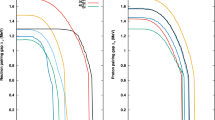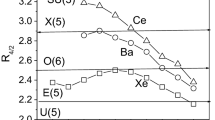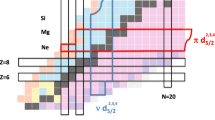Abstract
The phase transitions and spectral statistical properties in Nd, Sm, Gd, and Dy isotopes are investigated by spherical mean-field plus standard pairing model. The results of the model calculations successfully reproduce the critical phenomena observed experimentally in the two-neutron separation energy, odd–even mass differences, \(\alpha \)-decay, double \(\beta ^{-}\)-decay energy and the first pairing excitation states of these isotopes with the critical point at the neutron number \(N\sim 90\). As the only parameter in the model, the pairing interaction strength G is determined by fitting the binding energies, the odd–even mass differences and the energies of the first and second pairing excitation states for the \(^{144-157}\)Nd, \(^{146-159}\)Sm, \(^{148-161}\)Gd, and \(^{150-163}\)Dy isotopes. The spectral statistical properties of the excited levels of Sm isotopes show that the quantum chaos exists in \(^{151-153}\)Sm which corresponds to the critical point at \(N\sim 90\). It is inferred that the transitional region is the most sensitive region to perturbation, leading generically to the typical signature of quantum chaos. Moreover, the results indicate that this critical behavior is related not only to the ground-state but also to the excited-state under the present model. It may provide us a microscopic picture that the ground-state phase transition and the quantum chaos behaviors may drive by the competition between the spherical mean-field and the pairing interaction based on the present model for Nd, Sm, Gd, and Dy isotopes.













Similar content being viewed by others
Data Availability Statement
This manuscript has no associated data or the data will not be deposited. [Authors’ comment: All the data in the paper is available to be deposited.]
References
E.P. Wigner, Ann. Math. 53, 36 (1951)
E.P. Wigner, Ann. Math. 62, 548 (1955)
E.P. Wigner, Ann. Math. 65, 203 (1957)
E.P. Wigner, Ann. Math. 67, 325 (1958)
T.A. Brody, J. Flores, J.B. French, P.A. Mello, A. Pandey, S.S.M. Wong, Rev. Mod. Phys. 53, 385 (1981)
T. Guhr, A. Müller-Groeling, H.A. Weidenmüller, Phys. Rep. 299, 189 (1998). https://doi.org/10.1016/S0370-1573(97)00088-4
H.A. Weidenmüller, G.E. Mitchell, Rev. Mod. Phys. 81, 539 (2009). https://doi.org/10.1103/RevModPhys.81.539
O. Bohigas, M.J. Giannoni, C. Schmit, Phys. Rev. Lett. 52, 1 (1984). https://doi.org/10.1103/PhysRevLett.52.1
R.U. Haq, A. Pandey, O. Bohigas, Phys. Rev. Lett. 48, 1086 (1982). https://doi.org/10.1103/PhysRevLett.48.1086
M. Macek, P. Stránský, P. Cejnar, S. Heinze, J. Jolie, J. Dobeš, Phys. Rev. C 75, 064318 (2007). https://doi.org/10.1103/PhysRevC.75.064318
T.H. Seligman, J.J.M. Verbaarschot, M.R. Zirnbauer, Phys. Rev. Lett. 53, 215 (1984). https://doi.org/10.1103/PhysRevLett.53.215
D.C. Meredith, S.E. Koonin, M.R. Zirnbauer, Phys. Rev. A 37, 3499 (1988). https://doi.org/10.1103/PhysRevA.37.3499
W.M. Zhang, C.C. Martens, D.H. Feng, J.M. Yuan, Phys. Rev. Lett. 61, 2167 (1988). https://doi.org/10.1103/PhysRevLett.61.2167
Y. Alhassid, A. Novoselsky, N. Whelan, Phys. Rev. Lett. 65, 2971 (1990). https://doi.org/10.1103/PhysRevLett.65.2971
Y. Alhassid, N. Whelan, Phys. Rev. Lett. 67, 816 (1991). https://doi.org/10.1103/PhysRevLett.67.816
Y. Alhassid, N. Whelan, Phys. Rev. C 43, 2637 (1991). https://doi.org/10.1103/PhysRevC.43.2637
Y. Alhassid, A. Novoselsky, Phys. Rev. C 45, 1677 (1992). https://doi.org/10.1103/PhysRevC.45.1677
Y. Alhassid, D. Vretenar, Phys. Rev. C 46, 1334 (1992). https://doi.org/10.1103/PhysRevC.46.1334
N. Whelan, Y. Alhassid, Nucl. Phys. A 556, 42 (1993). https://doi.org/10.1016/0375-9474(93)90237-R
P. Cejnar, J. Jolie, Phys. Rev. E 58, 387 (1998). https://doi.org/10.1103/PhysRevE.58.387
N. Whelan, Y. Alhassid, A. Leviatan, Phys. Rev. Lett. 71, 2208 (1993). https://doi.org/10.1103/PhysRevLett.71.2208
D.M. Leitner, H. Köppel, L.S. Cederbaum, Phys. Rev. Lett. 73, 2970 (1994). https://doi.org/10.1103/PhysRevLett.73.2970
A. Leviatan, N.D. Whelan, Phys. Rev. Lett. 77, 5202 (1996). https://doi.org/10.1103/PhysRevLett.77.5202
D. Kusnezov, Phys. Rev. Lett. 79, 537 (1997). https://doi.org/10.1103/PhysRevLett.79.537
J.Z. Gu, X.Z. Wu, Y.Z. Zhuo, E.G. Zhao, Nucl. Phys. A 625, 621 (1997). https://doi.org/10.1016/S0375-9474(97)00503-4
F.Q. Chen, X.R. Zhou, J.Z. Gu, Chin. Phys. Lett. 27, 3 (2010). https://doi.org/10.1088/0256-307X/27/3/030503
W.D. Heiss, A.L. Sannino, Phys. Rev. A 43, 4159 (1991). https://doi.org/10.1103/PhysRevA.43.4159
W.D. Heiss, M. Müller, Phys. Rev. E 66, 016217 (2002). https://doi.org/10.1103/PhysRevE.66.016217
W.D. Heiss, R.G. Nazmitdinov, S. Radu, Phys. Rev. Lett. 72, 2351 (1994). https://doi.org/10.1103/PhysRevLett.72.2351
X. Guan, K.D. Launey, J.Z. Gu, F. Pan, J.P. Draayer, Phys. Rev. C 88, 044325 (2013)
X. Guan, H.C. Xu, F. Pan, J.P. Draayer, Phys. Rev. C 94, 024309 (2016)
X. Guan, H.C. Zhao, F. Pan, J.P. Draayer, Nucl. Phys. A 986, 86 (2019)
R.W. Richardson, Phys. Lett. 3, 277 (1963)
R.W. Richardson, Phys. Lett. 5, 82 (1963)
R.W. Richardson, N. Sherman, Nucl. Phys. 52, 221 (1964)
R.W. Richardson, N. Sherman, Nucl. Phys. 52, 253 (1964)
R.W. Richardson, N. Sherman, Nucl. Phys. M. Gaudin, J. Phys. 37, 1087 (1976)
X. Guan, K.D. Launey, M.X. Xie, L. Bao, F. Pan, J.P. Draayer, Phys. Rev. C 86, 024313 (2012)
X. Guan, K.D. Launey, M.X. Xie, L. Bao, F. Pan, J.P. Draayer, Comput. Phys. Commun. 185, 2714 (2014)
C. Qi, T. Chen, Phys. Rev. C 92, 051304(R) (2015)
G. Szegö, Amer. Math. Soc. Colloq. Publ., vol. 23 (American Mathematical Society, Providence, 1975)
F.J. Dyson, J. Math. Phys. 3, 140 (1962). https://doi.org/10.1063/1.1703773
F.J. Dyson, J. Math. Phys. 3, 157 (1962). https://doi.org/10.1063/1.1703774
F.J. Dyson, J. Math. Phys. 3, 166 (1962). https://doi.org/10.1063/1.1703775
F.J. Dyson, J. Math. Phys. 3, 1191 (1962). https://doi.org/10.1063/1.1703862
F.J. Dyson, J. Math. Phys. 3, 1199 (1962). https://doi.org/10.1063/1.1703863
M.L. Metha, Random Matrices, 2nd edn. (Academic Press, Boston, 1991)
G. Audi, A.H. Wapstra, C. Thibault, Nucl. Phys. A 729, 337 (2003)
J.A. Cameron, B. Singh, Nucl. Data Sheets 94, 429 (2001)
Z.Y. Wu, C. Qi, R. Wyss, H.L. Liu, Phys. Rev. C 92, 024306 (2015)
U.S. National Nuclear Data Center. http://www.nndc.bnl.gov/
Y. Zhang, L. Bao, X. Guan, F. Pan, J.P. Draayer, Phys. Rev. C 88, 064305 (2013)
F. Iachello, Phys. Rev. Lett. 85, 3580 (2000)
F. Iachello, Phys. Rev. Lett. 87, 052502 (2001)
F. Iachello, N.V. Zamfir, Phys. Rev. Lett. 92, 212501 (2004)
R.F. Casten, N.V. Zamfir, Phys. Rev. Lett. 85, 3584 (2000)
R.F. Casten, N.V. Zamfir, Phys. Rev. Lett. 87, 052503 (2001)
N. Minkov, P. Yotov, S. Drenska, W. Scheid, D. Bonatsos, D. Lenis, D. Petrellis, Phys. Rev. C 73, 044315 (2006)
N. Minkov, S. Drenska, M. Strecker, W. Scheid, H. Lenske, Phys. Rev. C 85, 034306 (2012)
A. Volya, V. Zelevinsky, Phys. Lett. B 574, 27 (1995)
M.A. Caprio, P. Cejnar, F. Iachello, Ann. Phys. 323, 1106–1135 (2008)
R.F. Casten, E.A. McCutchan, J. Phys. G34, R285 (2007)
P. Cejnar, J. Jolie, R.F. Casten, Rev. Mod. Phys. 82, 2155 (2010)
Acknowledgements
This work was supported by the NSFC (11790325) and the Chinese-Plolish joint project by NSFC (11961131010).
Author information
Authors and Affiliations
Corresponding author
Additional information
Communicated by Mark Caprio.
Single-particle energies deduced from experimental data
Single-particle energies deduced from experimental data
Calculations for Nd, Sm, Gd and Dy isotopes are performed for valence neutrons in the sixth HO shell with a model space of six j levels, \(f_{5/2,7/2}\), \(p_{1/2,3/2}\), \(h_{9/2}\), \(i_{13/2}\), the single-particle energies \(\epsilon _{j}\) in the model Hamiltonian (1) for those three isotopic chains deduced from experimental data. As an approximation, we neglected the proton pair-excitations, only valence neutron pair-excitations are considered. These estimates are obtained from the binding energy \(E_{B}(Z,82)\), the binding energy \(E_{B}(Z,83)\) and the energy spectrum \(E_{j}(Z,83)\). The single-particle energy \(\tilde{\epsilon _{j}}=E_{B}(Z,83)-E_{B}(Z,82)+E_{j}(Z,83)\). The average single-particle energy is defined by
The single-particle energy in Eq.(1) is given by \(\epsilon _{j}=\tilde{\epsilon _{j}}-\epsilon _{avg}\).
Calculations for \(^{144-157}\)Nd isotopes are performed for \(^{142}\)Nd core. The single-particle energies used for Eq.(1) are,
These estimates are obtained from the \(^{142}\) Nd binding energy \(E_{B}(60,82)\), \(^{143}\)Nd binding energy \(E_{B}(60,83)\) [48] and \(^{143}\)Nd energy spectrum \(E_{j}(60,83)\) [49]. The average single-particle energy (\(\epsilon _{avg}=-5.07\) MeV) is subtracted. For the odd-A systems, the lowest theoretical energy corresponds to the odd particle occupying the \(f_{7/2}\) level for \(^{145-153}\)Nd and for \(^{155-157}\)Nd the \(p_{3/2}\) level is to be blocked by the odd particle.
For \(^{146-159}\)Sm isotopes, The single-particle energies used for (1) are,
These estimates are obtained from the \(^{144}\)Sm binding energy \(E_{B}(62,82)\), \(^{145}\)Sm binding energy \(E_{B}(62,83)\) [48]and \(^{145}\)Sm energy spectrum \(E_{j}(62,83)\) [49]. The average single-particle energy (\(\epsilon _{avg}=-5.8\) MeV) is subtracted. For the odd-A systems, the lowest theoretical energy corresponds to the odd particle occupying the \(f_{7/2}\) level for \(^{147-157}\)Sm and for \(^{159}\)Sm the \(p_{3/2}\) level is to be blocked by the odd particle.
For \(^{148-161}\)Gd isotopes, The single-particle energies used for (1) are,
These estimates are obtained from the \(^{146}\)Gd binding energy \(E_{B}(64,82)\), \(^{147}\)Gd binding energy \(E_{B}(64,83)\) [48] and \(^{147}\)Gd energy spectrum \(E_{j}(64,83)\) [49]. The average single-particle energy (\(\epsilon _{avg}=-6.25\) MeV) is subtracted. For the odd-A systems, the lowest theoretical energy corresponds to the odd particle occupying the \(f_{7/2}\) level for \(^{149-159}\)Gd and for \(^{161}\)Gd the \(i_{13/2}\) level is to be blocked by the odd particle.
For \(^{150-163}\)Dy isotopes, The single-particle energies used for (1) are,
These estimates are obtained from the \(^{148}\)Dy binding energy \(E_{B}(66,82)\), \(^{149}\)Dy binding energy \(E_{B}(66,83)\) [48] and \(^{149}\)Dy energy spectrum \(E_{j}(66,83)\) [49]. The average single-particle energy (\(\epsilon _{avg}=-6.90\) MeV) is subtracted. For the odd-A systems, the lowest theoretical energy corresponds to the odd particle occupying the \(f_{7/2}\) level for \(^{151-159}\)Dy and for \(^{161-163}\)Dy the \(p_{3/2}\) level is to be blocked by the odd particle.
Rights and permissions
About this article
Cite this article
Yue, Y., Chen, Y. & Guan, X. Quantum phase transitions and spectral statistical properties in nuclei near \(N \sim 90\). Eur. Phys. J. A 56, 164 (2020). https://doi.org/10.1140/epja/s10050-020-00150-8
Received:
Accepted:
Published:
DOI: https://doi.org/10.1140/epja/s10050-020-00150-8




